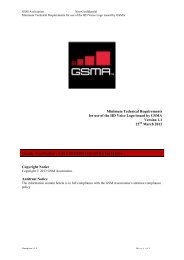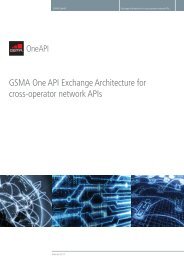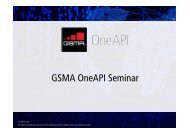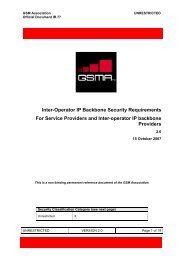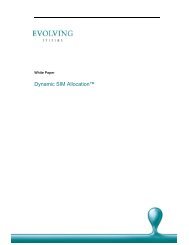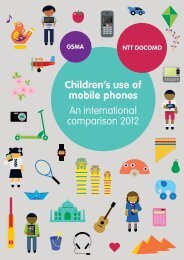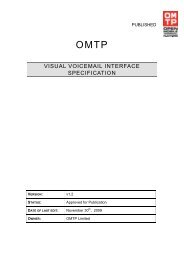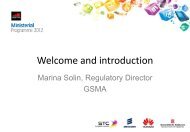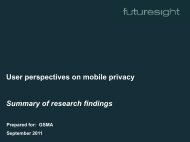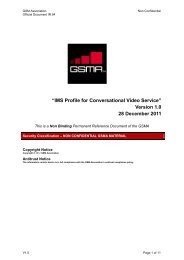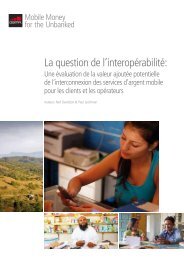IR.92 IMS Profile for Voice and SMS v6.0 (Current) - GSMA
IR.92 IMS Profile for Voice and SMS v6.0 (Current) - GSMA
IR.92 IMS Profile for Voice and SMS v6.0 (Current) - GSMA
Create successful ePaper yourself
Turn your PDF publications into a flip-book with our unique Google optimized e-Paper software.
GSM Association<br />
Official Document <strong>IR.92</strong> - <strong>IMS</strong> <strong>Profile</strong> <strong>for</strong> <strong>Voice</strong> <strong>and</strong> <strong>SMS</strong><br />
Non-confidential<br />
<strong>IMS</strong> <strong>Profile</strong> <strong>for</strong> <strong>Voice</strong> <strong>and</strong> <strong>SMS</strong><br />
Version 7.0<br />
03 March 2013<br />
This is a Non-binding Permanent Reference Document of the <strong>GSMA</strong><br />
Security Classification: Non-confidential<br />
Access to <strong>and</strong> distribution of this document is restricted to the persons permitted by the security classification. This document is confidential to the<br />
Association <strong>and</strong> is subject to copyright protection. This document is to be used only <strong>for</strong> the purposes <strong>for</strong> which it has been supplied <strong>and</strong><br />
in<strong>for</strong>mation contained in it must not be disclosed or in any other way made available, in whole or in part, to persons other than those permitted<br />
under the security classification without the prior written approval of the Association.<br />
Copyright Notice<br />
Copyright © 2013 GSM Association<br />
Disclaimer<br />
The GSM Association (“Association”) makes no representation, warranty or undertaking (express or implied) with respect to <strong>and</strong> does not accept<br />
any responsibility <strong>for</strong>, <strong>and</strong> hereby disclaims liability <strong>for</strong> the accuracy or completeness or timeliness of the in<strong>for</strong>mation contained in this document.<br />
The in<strong>for</strong>mation contained in this document may be subject to change without prior notice.<br />
Antitrust Notice<br />
The in<strong>for</strong>mation contain herein is in full compliance with the GSM Association’s antitrust compliance policy.<br />
V7.0 Page 1 of 32
GSM Association<br />
Official Document <strong>IR.92</strong> - <strong>IMS</strong> <strong>Profile</strong> <strong>for</strong> <strong>Voice</strong> <strong>and</strong> <strong>SMS</strong><br />
Non-confidential<br />
Table of Contents<br />
1 General Introduction 4<br />
1.1 The <strong>IMS</strong> <strong>Profile</strong> <strong>for</strong> <strong>Voice</strong> <strong>and</strong> <strong>SMS</strong> 4<br />
1.2 Relationship to existing st<strong>and</strong>ards 5<br />
1.2.1 3GPP specifications 5<br />
1.3 Scope 5<br />
1.4 Definition of Terms 5<br />
1.5 Document Cross-References 7<br />
2 <strong>IMS</strong> Feature Set 10<br />
2.1 General 10<br />
2.2 Support of generic <strong>IMS</strong> functions 10<br />
2.2.1 SIP Registration Procedures 10<br />
2.2.2 Authentication 11<br />
2.2.3 Addressing 12<br />
2.2.4 Call Establishment <strong>and</strong> Termination 13<br />
2.2.5 Forking 13<br />
2.2.6 Tracing of Signalling 13<br />
2.2.7 The use of Signalling Compression 13<br />
2.2.8 Early media <strong>and</strong> announcements 13<br />
2.3 Supplementary Services 14<br />
2.3.1 Supplementary Services Overview 14<br />
2.3.2 Supplementary Service Configuration 14<br />
2.3.3 Ad-Hoc Multi Party Conference 15<br />
2.3.4 Communication Waiting 16<br />
2.3.5 Message Waiting Indication 16<br />
2.3.6 Originating Identification Restriction 16<br />
2.3.7 Terminating Identification Restriction 16<br />
2.3.8 Communication Diversion 16<br />
2.3.9 Communication Barring 17<br />
2.4 Call Set-up Considerations 17<br />
2.4.1 SIP Precondition Considerations 17<br />
2.4.2 Integration of resource management <strong>and</strong> SIP 17<br />
2.4.3 <strong>Voice</strong> Media Considerations 18<br />
2.4.4 Multimedia Considerations 19<br />
2.5 <strong>SMS</strong> over IP 19<br />
3 <strong>IMS</strong> Media 19<br />
3.1 General 19<br />
3.2 <strong>Voice</strong> Media 20<br />
3.2.1 Codecs 20<br />
3.2.2 RTP <strong>Profile</strong> <strong>and</strong> SDP Considerations 21<br />
3.2.3 Data Transport 21<br />
3.2.4 RTCP Usage 21<br />
3.2.5 AMR Payload Format Considerations 22<br />
3.2.6 Jitter Buffer Management Considerations 23<br />
3.2.7 Front End H<strong>and</strong>ling 23<br />
3.3 DTMF Events 23<br />
4 Radio <strong>and</strong> Packet Core Feature Set 23<br />
4.0 General 23<br />
4.1 Robust Header Compression 23<br />
4.2 LTE Radio Capabilities 24<br />
4.2.1 Radio Bearers 24<br />
4.2.2 DRX Mode of Operation 24<br />
4.2.3 RLC configurations 24<br />
V7.0 Page 2 of 32
GSM Association<br />
Official Document <strong>IR.92</strong> - <strong>IMS</strong> <strong>Profile</strong> <strong>for</strong> <strong>Voice</strong> <strong>and</strong> <strong>SMS</strong><br />
Non-confidential<br />
4.2.4 GBR <strong>and</strong> NGBR Services, GBR Monitoring Function 24<br />
4.3 Bearer Management 25<br />
4.3.1 EPS Bearer Considerations <strong>for</strong> SIP Signalling <strong>and</strong> XCAP 25<br />
4.3.2 EPS Bearer Considerations <strong>for</strong> <strong>Voice</strong> 25<br />
4.4 P-CSCF Discovery 26<br />
5 Common Functionalities 26<br />
5.1 IP Version 26<br />
5.2 Emergency Service 26<br />
5.2.1 General 26<br />
5.3 Roaming Considerations 27<br />
Annex A Complementing <strong>IMS</strong> with CS 28<br />
A.1 General 28<br />
A.2 Domain Selection 28<br />
A.3 SR-VCC 28<br />
A.4 <strong>IMS</strong> <strong>Voice</strong> service settings management when using CS access 28<br />
A.5 Emergency Service 29<br />
A.6 Roaming Considerations 30<br />
A.7 <strong>SMS</strong> Support 30<br />
Annex B Features Needed In Certain Markets 31<br />
B.1 General 31<br />
B.2 Global Text Telephony 31<br />
B.3 Service Specific Access Control 31<br />
Document Management 32<br />
Document History 32<br />
Other In<strong>for</strong>mation 32<br />
V7.0 Page 3 of 32
GSM Association<br />
Official Document <strong>IR.92</strong> - <strong>IMS</strong> <strong>Profile</strong> <strong>for</strong> <strong>Voice</strong> <strong>and</strong> <strong>SMS</strong><br />
Non-confidential<br />
1 General Introduction<br />
1.1 The <strong>IMS</strong> <strong>Profile</strong> <strong>for</strong> <strong>Voice</strong> <strong>and</strong> <strong>SMS</strong><br />
The IP Multimedia Subsystem (<strong>IMS</strong>) <strong>Profile</strong> <strong>for</strong> <strong>Voice</strong> <strong>and</strong> <strong>SMS</strong>, documented in this<br />
Permanent Reference Document (PRD), defines a profile that identifies a minimum<br />
m<strong>and</strong>atory set of features which are defined in 3GPP specifications that a wireless device<br />
(the User Equipment (UE)) <strong>and</strong> network are required to implement in order to guarantee an<br />
interoperable, high quality <strong>IMS</strong>-based telephony service over Long Term Evolution (LTE)<br />
radio access. The scope includes the following aspects:<br />
• <strong>IMS</strong> basic capabilities <strong>and</strong> supplementary services <strong>for</strong> telephony [Chapter 2]<br />
• Real-time media negotiation, transport, <strong>and</strong> codecs [Chapter 3]<br />
• LTE radio <strong>and</strong> evolved packet core capabilities [Chapter 4]<br />
• Functionality that is relevant across the protocol stack <strong>and</strong> subsystems [Chapter 5].<br />
The UE <strong>and</strong> network protocol stacks <strong>for</strong>ming the scope of the <strong>IMS</strong> <strong>Profile</strong> <strong>for</strong> <strong>Voice</strong> <strong>and</strong> <strong>SMS</strong><br />
are depicted in figure 1.1 below:<br />
Suppl.<br />
services<br />
SIP<br />
Codecs<br />
HTTP/<br />
HTTP/<br />
XCAP RTP/RTCP<br />
SIP XCAP<br />
RTP/RTCP<br />
TCP/IP - UDP/IP<br />
Bearers/QoS RoHC<br />
LTE<br />
with VoIP optimizations<br />
TCP/IP – UDP/IP<br />
Bearers/QoS RoHC<br />
LTE<br />
with VoIP optimizations<br />
Suppl.<br />
services<br />
Codecs<br />
TCP/IP - UDP/IP<br />
Mobile device Radio & access network Servers (<strong>IMS</strong>)<br />
Figure 1.1: Depiction of UE <strong>and</strong> Network Protocol Stacks in <strong>IMS</strong> <strong>Profile</strong> <strong>for</strong> <strong>Voice</strong><br />
The main body of this PRD is applicable <strong>for</strong> a scenario where <strong>IMS</strong> telephony is deployed<br />
over LTE in a st<strong>and</strong>alone fashion without relying on any legacy infrastructure, packet or<br />
circuit switched. In order to be compliant with <strong>IMS</strong> <strong>Profile</strong> <strong>for</strong> <strong>Voice</strong> <strong>and</strong> <strong>SMS</strong>, the UEs <strong>and</strong><br />
networks must be compliant with all of the normative statements in the main body.<br />
Annex A defines the profile <strong>for</strong> an alternative approach where <strong>IMS</strong> telephony is deployed<br />
with a certain degree of reliance on an existing 3GPP circuit switched network infrastructure.<br />
Whenever there are additional requirements to the main profile, these are explicitly stated. In<br />
order to be compliant with the functionality described in Annex A, the UEs <strong>and</strong> networks<br />
must be compliant with all of the normative statements in Annex A as well as to all of the<br />
normative statements in the main body of the PRD that are unaltered by Annex A.<br />
V7.0 Page 4 of 32
GSM Association<br />
Official Document <strong>IR.92</strong> - <strong>IMS</strong> <strong>Profile</strong> <strong>for</strong> <strong>Voice</strong> <strong>and</strong> <strong>SMS</strong><br />
Non-confidential<br />
1.2 Relationship to existing st<strong>and</strong>ards<br />
1.2.1 3GPP specifications<br />
This profile is solely based on the open <strong>and</strong> published 3GPP specifications as listed in the<br />
Section 1.5. 3GPP Release 8, the first release supporting LTE, is taken as a basis. It should<br />
be noted, however that not all the features m<strong>and</strong>atory in 3GPP Release 8 are required <strong>for</strong><br />
compliance with this profile.<br />
Conversely, some features required <strong>for</strong> compliance with this profile are based on<br />
functionality defined in 3GPP Release 9 or higher releases.<br />
All such exceptions are explicitly mentioned in the following sections along with the relevant<br />
Release 8 or higher 3GPP release specifications, respectively.<br />
Unless otherwise stated, the latest version of the referenced specifications <strong>for</strong> the relevant<br />
3GPP release applies.<br />
1.3 Scope<br />
This document defines a voice over <strong>IMS</strong> profile by listing a number of Evolved Universal<br />
Terrestrial Radio Access Network (E-UTRAN), Evolved Packet Core, <strong>IMS</strong> core, <strong>and</strong> UE<br />
features which are considered essential to launch interoperable <strong>IMS</strong> based voice. The<br />
defined profile is compliant with 3GPP specifications. The scope of this version of the profile<br />
is the interface between UE <strong>and</strong> network.<br />
Note:<br />
Although, this version of the specification focuses on E-UTRAN, the defined<br />
<strong>IMS</strong> functionalities may be applied to other IP Connectivity Accesses.<br />
The profile does not limit anybody, by any means, to deploy other st<strong>and</strong>ardized features or<br />
optional features, in addition to the defined profile.<br />
1.4 Definition of Terms<br />
Term<br />
3GPP<br />
AM<br />
AMR<br />
AMR-WB<br />
APN<br />
AVP<br />
AVPF<br />
CB<br />
CDIV<br />
CDIVN<br />
CFNL<br />
CFNRc<br />
CN<br />
Description<br />
3rd Generation Partnership Project<br />
Acknowledged Mode<br />
Adaptive Multi-Rate<br />
Adaptive Multi-Rate Wideb<strong>and</strong><br />
Access Point Name<br />
Audio Video <strong>Profile</strong><br />
AVP Feedback <strong>Profile</strong><br />
Communication Barring<br />
Communication Diversion<br />
CDIV Notification<br />
Communication Forwarding on Not Logged-in<br />
Communication Forwarding on Not Reachable<br />
Core Network<br />
V7.0 Page 5 of 32
GSM Association<br />
Official Document <strong>IR.92</strong> - <strong>IMS</strong> <strong>Profile</strong> <strong>for</strong> <strong>Voice</strong> <strong>and</strong> <strong>SMS</strong><br />
Non-confidential<br />
Term Description<br />
CS Circuit Switched<br />
CSFB CS Fallback<br />
CW Communication Waiting<br />
DRB Data Radio Bearer<br />
DRX Discontinuous Reception<br />
DTX Discontinuous Transmission<br />
eNB eNodeB<br />
EPS Evolved Packet System<br />
E-UTRAN Evolved Universal Terrestrial Radio Access Network<br />
FDD Frequency-Division Duplexing<br />
GBR Guaranteed Bit Rate<br />
GRUU Globally Routable User agent URI<br />
GSM Global System <strong>for</strong> Mobile communications<br />
ICS <strong>IMS</strong> Centralized Services<br />
ICSI <strong>IMS</strong> Communication Service Identifier<br />
IM<br />
IP Multimedia<br />
IMPU IP Multimedia Public Identity<br />
<strong>IMS</strong> IP Multimedia Subsystem<br />
<strong>IMS</strong>-AKA <strong>IMS</strong> Authentication <strong>and</strong> Key Agreement<br />
<strong>IMS</strong>I International Mobile Subscriber Identity<br />
IP<br />
Internet Protocol<br />
IPv4 Internet Protocol Version 4<br />
IPv6 Internet Protocol Version 6<br />
ISIM IM Services Identity Module<br />
LTE Long Term Evolution<br />
MMTel Multimedia Telephony<br />
MO Managed Object<br />
MS Mobile Station<br />
MS-ISDN Mobile Subscriber ISDN Number<br />
MWI Message Waiting Indication<br />
NGBR Non Guaranteed Bit Rate<br />
PCC Policy <strong>and</strong> Charging Control<br />
PCRF Policy <strong>and</strong> Charging Rules Function<br />
P-CSCF Proxy - Call Session Control Function<br />
PDN Packet Data Network<br />
PS Packet Switched<br />
QCI Quality of Service Class Indicator<br />
RAT Radio Access Technology<br />
V7.0 Page 6 of 32
GSM Association<br />
Official Document <strong>IR.92</strong> - <strong>IMS</strong> <strong>Profile</strong> <strong>for</strong> <strong>Voice</strong> <strong>and</strong> <strong>SMS</strong><br />
Non-confidential<br />
Term<br />
RLC<br />
RoHC<br />
RTCP<br />
RTP<br />
SCC AS<br />
SDP<br />
SigComp<br />
SIP<br />
<strong>SMS</strong>oIP<br />
SRB<br />
SR-VCC<br />
TAS<br />
TDD<br />
TFO<br />
TrFO<br />
UDP<br />
UE<br />
UICC<br />
UM<br />
URI<br />
VoIP<br />
XCAP<br />
XML<br />
Description<br />
Radio Link Control<br />
Robust Header Compression<br />
RTP Control Protocol<br />
Real Time Protocol<br />
Service Centralization <strong>and</strong> Continuity Application Server<br />
Session Description Protocol<br />
Signalling Compression<br />
Session Initiation Protocol<br />
<strong>SMS</strong> over IP<br />
Signalling Radio Bearer<br />
Single Radio <strong>Voice</strong> Call Continuity<br />
Telephony Application Server<br />
Time-Division Duplexing<br />
T<strong>and</strong>em-Free Operation<br />
Transcoder-Free Operation<br />
User Datagram Protocol<br />
User Equipment<br />
Universal Integrated Circuit Card<br />
Unacknowledged Mode<br />
Uni<strong>for</strong>m Resource Identifier<br />
<strong>Voice</strong> Over IP<br />
XML Configuration Access Protocol<br />
eXtensible Markup Language<br />
1.5 Document Cross-References<br />
Ref Doc Number Title<br />
[1] 3GPP TS 22.011 Service Accessibility<br />
[2] 3GPP TS 23.003 Numbering, addressing <strong>and</strong> identification<br />
[3] 3GPP TS 23.167 IP Multimedia Subsystem (<strong>IMS</strong>) emergency sessions<br />
[4] 3GPP TS 23.203 Policy <strong>and</strong> charging control architecture<br />
[5] 3GPP TS 23.216 Single Radio <strong>Voice</strong> Call Continuity (SRVCC); Stage 2<br />
[6] 3GPP TS 23.221 Architectural requirements<br />
[7] 3GPP TS 23.228 IP Multimedia Subsystem (<strong>IMS</strong>); Stage 2<br />
[8] 3GPP TS 23.237 IP Multimedia Subsystem (<strong>IMS</strong>) Service Continuity; Stage 2<br />
[9] 3GPP TS 23.272 Circuit Switched (CS) fallback in Evolved Packet System (EPS); Stage<br />
2<br />
[10] 3GPP TS 23.401 General Packet Radio Service (GPRS) enhancements <strong>for</strong> Evolved<br />
Universal Terrestrial Radio Access Network (E-UTRAN) access<br />
[11] 3GPP TS 24.008 Mobile radio interface layer 3 specification; Core Network protocols;<br />
V7.0 Page 7 of 32
GSM Association<br />
Official Document <strong>IR.92</strong> - <strong>IMS</strong> <strong>Profile</strong> <strong>for</strong> <strong>Voice</strong> <strong>and</strong> <strong>SMS</strong><br />
Non-confidential<br />
Ref Doc Number Title<br />
Stage 3<br />
[12] 3GPP TS 24.109 Bootstrapping interface (Ub) <strong>and</strong> network application function interface<br />
(Ua); Protocol details<br />
[13] 3GPP TS 24.147 Conferencing using the IP Multimedia (IM) Core Network (CN)<br />
subsystem; Stage 3<br />
[14] 3GPP TS 24.173 <strong>IMS</strong> Multimedia telephony service <strong>and</strong> supplementary services; Stage<br />
3<br />
[15] 3GPP TS 24.229 IP multimedia call control protocol based on Session Initiation Protocol<br />
(SIP) <strong>and</strong> Session Description Protocol (SDP); Stage 3<br />
[16] 3GPP TS 24.237 IP Multimedia Subsystem (<strong>IMS</strong>) Service Continuity; Stage 3<br />
[17] 3GPP TS 24.301 Non-Access-Stratum (NAS) protocol <strong>for</strong> Evolved Packet System (EPS);<br />
Stage 3<br />
[18] 3GPP TS 24.305 Selective Disabling of 3GPP User Equipment Capabilities (SDoUE)<br />
Management Object (MO)<br />
[19] 3GPP TS 24.341 Support of <strong>SMS</strong> over IP networks; Stage 3<br />
[20] 3GPP TS 24.604 Communication Diversion (CDIV) using IP Multimedia (IM)Core<br />
Network (CN) subsystem; Protocol specification<br />
[21] 3GPP TS 24.605 Conference (CONF) using IP Multimedia (IM) Core Network (CN)<br />
subsystem; Protocol specification<br />
[22] 3GPP TS 24.606 Message Waiting Indication (MWI )using IP Multimedia (IM) Core<br />
Network (CN) subsystem; Protocol specification<br />
[23] 3GPP TS 24.607 Originating Identification Presentation (OIP) <strong>and</strong> Originating<br />
Identification Restriction (OIR) using IP Multimedia (IM) Core Network<br />
(CN) subsystem; Protocol specification<br />
[24] 3GPP TS 24.608 Terminating Identification Presentation (TIP) <strong>and</strong> Terminating<br />
Identification Restriction (TIR) using IP Multimedia (IM) Core Network<br />
(CN) subsystem; Protocol specification<br />
[25] 3GPP TS 24.610 Communication HOLD (HOLD) using IP Multimedia (IM) Core Network<br />
(CN) subsystem; Protocol specification<br />
[26] 3GPP TS 24.611 Anonymous Communication Rejection (ACR) <strong>and</strong> Communication<br />
Barring (CB) using IP Multimedia (IM) Core Network (CN) subsystem;<br />
Protocol specification<br />
[27] 3GPP TS 24.615 Communication Waiting (CW) using IP Multimedia (IM) Core Network<br />
(CN) subsystem; Protocol Specification<br />
[28] 3GPP TS 24.623 Extensible Markup Language (XML) Configuration Access Protocol<br />
(XCAP) over the Ut interface <strong>for</strong> Manipulating Simulation Services<br />
[29] 3GPP TS 26.071 M<strong>and</strong>atory speech CODEC speech processing functions; AMR speech<br />
Codec; General description<br />
[30] 3GPP TS 26.073 ANSI C code <strong>for</strong> the Adaptive Multi Rate (AMR) speech codec<br />
[31] 3GPP TS 26.090 M<strong>and</strong>atory Speech Codec speech processing functions; Adaptive<br />
Multi-Rate (AMR) speech codec; Transcoding functions<br />
[32] 3GPP TS 26.093 M<strong>and</strong>atory speech codec speech processing functions Adaptive Multi-<br />
Rate (AMR) speech codec; Source controlled rate operation<br />
V7.0 Page 8 of 32
GSM Association<br />
Official Document <strong>IR.92</strong> - <strong>IMS</strong> <strong>Profile</strong> <strong>for</strong> <strong>Voice</strong> <strong>and</strong> <strong>SMS</strong><br />
Non-confidential<br />
Ref Doc Number Title<br />
[33] 3GPP TS 26.103 Speech codec list <strong>for</strong> GSM <strong>and</strong> UMTS<br />
[34] 3GPP TS 26.104 ANSI-C code <strong>for</strong> the floating-point Adaptive Multi-Rate (AMR) speech<br />
codec<br />
[35] 3GPP TS 26.114 IP Multimedia Subsystem (<strong>IMS</strong>); Multimedia telephony; Media h<strong>and</strong>ling<br />
<strong>and</strong> interaction<br />
[36] 3GPP TS 26.131 Terminal acoustic characteristics <strong>for</strong> telephony; Requirements<br />
[37] 3GPP TS 26.132 Speech <strong>and</strong> video telephony terminal acoustic test specification<br />
[38] 3GPP TS 26.171 Speech codec speech processing functions; Adaptive Multi-Rate -<br />
Wideb<strong>and</strong> (AMR-WB) speech codec; General description<br />
[39] 3GPP TS 26.173 ANSI-C code <strong>for</strong> the Adaptive Multi-Rate - Wideb<strong>and</strong> (AMR-WB)<br />
speech codec<br />
[40] 3GPP TS 26.190 Speech codec speech processing functions; Adaptive Multi-Rate -<br />
Wideb<strong>and</strong> (AMR-WB) speech codec; Transcoding functions<br />
[41] 3GPP TS 26.193 Speech codec speech processing functions; Adaptive Multi-Rate -<br />
Wideb<strong>and</strong> (AMR-WB) speech codec; Source controlled rate operation<br />
[42] 3GPP TS 26.204 Speech codec speech processing functions; Adaptive Multi-Rate -<br />
Wideb<strong>and</strong> (AMR-WB) speech codec; ANSI-C code<br />
[43] 3GPP TS 27.007 AT comm<strong>and</strong> set <strong>for</strong> User Equipment (UE)<br />
[44] 3GPP TS 31.103 Characteristics of the IP Multimedia Services Identity Module (ISIM)<br />
application<br />
[45] 3GPP TS 33.203 3G security; Access security <strong>for</strong> IP-based services<br />
[46] 3GPP TS 33.222 Generic Authentication Architecture (GAA); Access to network<br />
application functions using Hypertext Transfer Protocol over Transport<br />
Layer Security (HTTPS)<br />
[47] 3GPP TS 36.101 Evolved Universal Terrestrial Radio Access (E-UTRA); User<br />
Equipment (UE) radio transmission <strong>and</strong> reception<br />
[48] 3GPP TS 36.104 Evolved Universal Terrestrial Radio Access (E-UTRA); Base Station<br />
(BS) radio transmission <strong>and</strong> reception<br />
[49] 3GPP TS 36.300 Evolved Universal Terrestrial Radio Access (E-UTRA) <strong>and</strong> Evolved<br />
Universal Terrestrial Radio Access Network (E-UTRAN); Overall<br />
description; Stage 2<br />
[50] 3GPP TS 36.321 Evolved Universal Terrestrial Radio Access (E-UTRA); Medium Access<br />
Control (MAC) protocol specification<br />
[51] 3GPP TS 36.323 Evolved Universal Terrestrial Radio Access (E-UTRA); Packet Data<br />
Convergence Protocol (PDCP) specification<br />
[52] 3GPP TS 36.331 Evolved Universal Terrestrial Radio Access (E-UTRA);Radio Resource<br />
Control (RRC); Protocol specification<br />
[53] IETF RFC 768 User Datagram Protocol<br />
[54] IETF RFC 3095 RObust Header Compression (ROHC): Framework <strong>and</strong> four profiles:<br />
RTP, UDP, ESP, <strong>and</strong> uncompressed<br />
[55] IETF RFC 3261 SIP: Session Initiation Protocol<br />
[56] IETF RFC 3550 RTP: A Transport Protocol <strong>for</strong> Real-Time Applications<br />
V7.0 Page 9 of 32
GSM Association<br />
Official Document <strong>IR.92</strong> - <strong>IMS</strong> <strong>Profile</strong> <strong>for</strong> <strong>Voice</strong> <strong>and</strong> <strong>SMS</strong><br />
Non-confidential<br />
Ref Doc Number Title<br />
[57] IETF RFC 3551 RTP <strong>Profile</strong> <strong>for</strong> Audio <strong>and</strong> Video Conferences with Minimal Control<br />
[58] IETF RFC 3556 Session Description Protocol (SDP) B<strong>and</strong>width Modifiers <strong>for</strong> RTP<br />
Control Protocol (RTCP) B<strong>and</strong>width<br />
[59] IETF RFC 3680 A Session Initiation Protocol (SIP) Event Package <strong>for</strong> Registrations<br />
[60] IETF RFC 3842 A Message Summary <strong>and</strong> Message Waiting Indication Event Package<br />
<strong>for</strong> the Session Initiation Protocol (SIP)<br />
[61] IETF RFC 4575 A Session Initiation Protocol (SIP) Event Package <strong>for</strong> Conference State<br />
[62] IETF RFC 4815 RObust Header Compression (ROHC): Corrections <strong>and</strong> Clarifications<br />
to RFC 3095<br />
[63] IETF RFC 4867 RTP Payload Format <strong>and</strong> File Storage Format <strong>for</strong> the Adaptive Multi-<br />
Rate (AMR) <strong>and</strong> Adaptive Multi-Rate Wideb<strong>and</strong> (AMR-WB) Audio<br />
Codecs<br />
[64] draft-ietf-mmusicsdp-capabilitynegotiation-10<br />
SDP Capability Negotiation<br />
[65] <strong>GSMA</strong> PRD IR.65 <strong>IMS</strong> Roaming <strong>and</strong> Interworking Guidelines<br />
[66] <strong>GSMA</strong> PRD IR.67 DNS/ENUM Guidelines <strong>for</strong> Service Providers <strong>and</strong> GRX/IPX Providers<br />
[67] <strong>GSMA</strong> PRD IR.88 LTE Roaming Guidelines<br />
[68] 3GPP TS 24.167 3GPP <strong>IMS</strong> Management Object (MO); Stage 3<br />
[69] 3GPP TS 36.322 Evolved Universal Terrestrial Radio Access (E-UTRA); Radio Link<br />
Control (RLC) protocol specification<br />
[70] ITU-T<br />
Recommendation<br />
T.140<br />
Protocol <strong>for</strong> multimedia application text conversation<br />
[71] 3GPP TS 24.628 Common Basic Communication procedures using IP Multimedia (IM)<br />
Core Network (CN) subsystem; Protocol specification<br />
[72] IETF RFC 4961 Symmetric RTP / RTP Control Protocol (RTCP)<br />
2 <strong>IMS</strong> Feature Set<br />
2.1 General<br />
The <strong>IMS</strong> profile part lists the m<strong>and</strong>atory capabilities, which are required over the Gm <strong>and</strong> Ut<br />
reference points.<br />
2.2 Support of generic <strong>IMS</strong> functions<br />
2.2.1 SIP Registration Procedures<br />
UE <strong>and</strong> <strong>IMS</strong> core network must follow the Session Initiated Protocol (SIP) registration<br />
procedures defined in 3GPP TS 24.229 [15]. In addition, when the conditions <strong>for</strong> per<strong>for</strong>ming<br />
<strong>IMS</strong> registration in bullets 2, 3, 4, 5 <strong>and</strong> 6 in section L.3.1.2 of 3GPP TS 24.229 [15] evaluate<br />
to true, then the UE must register with the <strong>IMS</strong>. Selective Disabling of 3GPP User Equipment<br />
Capabilities as defined in 3GPP TS 24.305 [18] is not m<strong>and</strong>ated in this profile, there<strong>for</strong>e in<br />
V7.0 Page 10 of 32
GSM Association<br />
Official Document <strong>IR.92</strong> - <strong>IMS</strong> <strong>Profile</strong> <strong>for</strong> <strong>Voice</strong> <strong>and</strong> <strong>SMS</strong><br />
Non-confidential<br />
the case where 3GPP TS 24.305 [18] Managed Object (MO) is not deployed, it is assumed<br />
that <strong>IMS</strong> is enabled in the terminal.<br />
Note 1:<br />
UE registering with <strong>IMS</strong> in other situations is possible.<br />
The UE must include <strong>IMS</strong> Communication Service Identifier (ICSI) value used to indicate the<br />
<strong>IMS</strong> Multimedia Telephony service, that being urn:urn-7:3gpp-service.ims.icsi.mmtel per<br />
3GPP TS 24.173 [14], using procedures as defined in section 5.1.1.2.1 of 3GPP TS 24.229<br />
[15]. If the UE supports <strong>SMS</strong> over IP (see section 2.5 <strong>and</strong> A.7), it must include feature tag<br />
used to indicate <strong>SMS</strong> over IP service, that being +g.3gpp.smsip as defined in section 5.3.2.2<br />
of 3GPP TS 24.341 [19].<br />
UE <strong>and</strong> <strong>IMS</strong> core network must support network-initiated de-registration as defined in 3GPP<br />
TS 24.229 [15].<br />
The UE must subscribe to the registration event package as defined in section 5.1.1.3 of<br />
3GPP TS 24.229 [15].<br />
The UE must include an IMEI URN (see 3GPP TS 23.003 [2] section 13.8) in the<br />
"+sip.instance" header field parameter (Instance ID) of the Contact address.<br />
All <strong>IMS</strong> public user identities provided in the implicit registration set used <strong>for</strong> VoLTE by the<br />
<strong>IMS</strong> core network must be alias user identities <strong>and</strong> must include a Tel URI. The following<br />
public user identity must be assigned to the implicit registration set used <strong>for</strong> VoLTE <strong>and</strong> it<br />
must be used by the UE when registering <strong>for</strong> VoLTE:<br />
a) When ISIM is used, the public user identity in the first (or only) record in the<br />
Elementary File in the ISIM (see 3GPP TS 31.103 [44] section 4.2.4); or<br />
b) The temporary public user identity derived from the <strong>IMS</strong>I (3GPP TS 24.229 [15]).<br />
No other implicit registration set must be used <strong>for</strong> VoLTE.<br />
Note 2:<br />
According to 3GPP TS 23.228 [7], a public user identity is an alias of<br />
another public user identity if both identities belong to the same implicit<br />
registration set, are linked to the same service profile <strong>and</strong> have the same<br />
service data configured <strong>for</strong> each <strong>and</strong> every service.<br />
2.2.2 Authentication<br />
UE <strong>and</strong> <strong>IMS</strong> core network must follow the procedures defined in 3GPP TS 24.229 [15] <strong>and</strong><br />
3GPP TS 33.203 [45] <strong>for</strong> authentication with <strong>IMS</strong> Authentication <strong>and</strong> Key Agreement (<strong>IMS</strong>-<br />
AKA), Sec-Agree <strong>and</strong> IPSec. Support of integrity protection is required <strong>for</strong> both UE <strong>and</strong><br />
network. Confidentiality protection is optional, considering that lower layer security is<br />
available.<br />
The <strong>IMS</strong> core network must support the procedures <strong>for</strong> IM Services Identity Module (ISIM)<br />
based authentication. Support <strong>for</strong> ISIM based authentication in the UE is m<strong>and</strong>atory.<br />
UE <strong>and</strong> <strong>IMS</strong> core network must the support the procedures <strong>for</strong> USIM based authentication in<br />
case there is no ISIM present on the Universal Integrated Circuit Card (UICC) as defined in<br />
3GPP TS 23.228 [7], Annex E.3.1 <strong>and</strong> 3GPP TS 24.229 [15], Annex C.2. This includes<br />
V7.0 Page 11 of 32
GSM Association<br />
Official Document <strong>IR.92</strong> - <strong>IMS</strong> <strong>Profile</strong> <strong>for</strong> <strong>Voice</strong> <strong>and</strong> <strong>SMS</strong><br />
Non-confidential<br />
support <strong>for</strong> the P-Associated Uni<strong>for</strong>m Resource Identifier (URI) header to h<strong>and</strong>le barred IP<br />
Multimedia Public Identities (IMPUs).<br />
UE <strong>and</strong> <strong>IMS</strong> core network must support the procedures <strong>for</strong> authentication at the Ut reference<br />
point as specified in 3GPP TS 24.623 [28].<br />
Note 1:<br />
It is recommended that the UE supports the Generic Authentication<br />
Architecture procedures specified in 3GPP TS 24.623 [28], 3GPP TS 33.222<br />
[46] <strong>and</strong> 3GPP TS 24.109 [12].<br />
The UE must support receiving 2xx response to the HTTP request without being challenged<br />
by 401 Unauthorized response.<br />
Note 2:<br />
The above authentication scenario is possible only if the APN <strong>for</strong> XCAP (see<br />
section 4.3.1) is routed to home PLMN. The home network is able to<br />
authenticate the UE without challenging the UE <strong>for</strong> Ut authentication.<br />
2.2.3 Addressing<br />
The UE <strong>and</strong> <strong>IMS</strong> core network must support Public User Identities as defined in section 13.4<br />
of 3GPP TS 23.003, which includes all of the following types of addresses:<br />
• Alphanumeric SIP-URIs<br />
• Example: sip:voicemail@example.com<br />
• MSISDN represented as a SIP URI:<br />
• Example: sip:+447700900123@example.com;user=phone<br />
• MSISDN represented as a Tel URI:<br />
• Example: tel:+447700900123<br />
Note:<br />
Further requirements <strong>for</strong> support of Public User Identities in the network are<br />
specified in IR.65 [].<br />
The UE <strong>and</strong> <strong>IMS</strong> core network must support the local numbers as defined in Alternative 2 in<br />
Sections 5.1.2A.1.3 <strong>and</strong> 5.1.2A.1.5 in 3GPP TS 24.229 [15]. That is, the UE must set the<br />
dial string containing the local number to the user part of SIP URI in the Request URI, <strong>and</strong><br />
set the "user=phone" parameter, with the “phone-context” Tel URI parameter to the user<br />
part.<br />
The UE must set the “phone-context” parameter as defined in section 7.2A.10 in 3GPP TS<br />
24.229 [15]. That is, <strong>for</strong> home local numbers the UE must set the “phone-context” parameter<br />
to the home domain name, as it is used to address the SIP REGISTER request. The UE <strong>and</strong><br />
network have the option to support geo-local numbers. If the UE supports geo-local<br />
numbers, it must set the “phone-context” parameter as with home local numbers, but<br />
prefixed by the “geo-local.” string, according to the Alternative 8 in Section 7.2A.10.3 in<br />
3GPP TS 24.229 [15].<br />
The UE <strong>and</strong> <strong>IMS</strong> core network must support the P-Called-Party-ID header field; the network<br />
must use this header field as defined in 3GPP TS 24.229 [15].<br />
V7.0 Page 12 of 32
GSM Association<br />
Official Document <strong>IR.92</strong> - <strong>IMS</strong> <strong>Profile</strong> <strong>for</strong> <strong>Voice</strong> <strong>and</strong> <strong>SMS</strong><br />
Non-confidential<br />
The support of Globally Routable User agent URIs (GRUUs) by UE or network is not<br />
required.<br />
2.2.4 Call Establishment <strong>and</strong> Termination<br />
UE <strong>and</strong> <strong>IMS</strong> core network must follow 3GPP TS 24.229 [15] <strong>for</strong> establishment <strong>and</strong><br />
termination of a call.<br />
UE <strong>and</strong> <strong>IMS</strong> core network must support reliable provisional responses.<br />
The UE shall be able to accept an INVITE request without an SDP offer <strong>and</strong> the UE shall<br />
include an SDP offer with audio media in the first non-failure reliable response to an INVITE<br />
request without SDP offer.<br />
Note:<br />
Other media can be included in the SDP offer in the first non-failure reliable<br />
response.<br />
For the purpose of indicating an <strong>IMS</strong> communication service to the network, the UE must<br />
use an ICSI value in accordance with 3GPP TS 24.229 [15]. The ICSI value used must<br />
indicate the <strong>IMS</strong> Multimedia Telephony service, which is urn:urn-7:3gppservice.ims.icsi.mmtel,<br />
as specified in 3GPP TS 24.173 [14].<br />
The usage of preconditions is discussed in Section 2.4.<br />
2.2.5 Forking<br />
Forking in the network is outside the scope of the present document. However <strong>for</strong> interoperability<br />
<strong>and</strong> <strong>for</strong>ward-compatibility reasons, the UE must be ready to receive responses<br />
generated due to a <strong>for</strong>ked request <strong>and</strong> behave according to the procedures specified in IETF<br />
RFC 3261 [55], section 4.2.7.3 of 3GPP TS 23.228 [7] <strong>and</strong> 3GPP TS 24.229 [15].<br />
Furthermore, the UE should be able to maintain at least seven (7) parallel early dialogues<br />
until receiving the final response on one of them <strong>and</strong> the UE must support receiving media<br />
on one of these early dialogues.<br />
2.2.6 Tracing of Signalling<br />
The UE <strong>and</strong> the network are not required to support Tracing of Signalling, as described in<br />
3GPP TS 24.229 [15] section 4.8, <strong>and</strong> are not required to subscribe to the debug event<br />
package as described in sections 5.1.1.3A <strong>and</strong> 5.2.3A.<br />
2.2.7 The use of Signalling Compression<br />
The UE must not use SIGCOMP when the initial <strong>IMS</strong> registration is per<strong>for</strong>med in E-UTRAN<br />
access.<br />
Note:<br />
Although this version of the profile focuses on E-UTRAN, if the initial <strong>IMS</strong><br />
registration occurs in other IP Connectivity Accesses then SIGCOMP can be<br />
used by the UE.<br />
2.2.8 Early media <strong>and</strong> announcements<br />
If the UE detects that in-b<strong>and</strong> in<strong>for</strong>mation is received from the network as early media, the<br />
in-b<strong>and</strong> in<strong>for</strong>mation received from the network shall override locally generated<br />
communication progress in<strong>for</strong>mation as described in 3GPP TS 24.628 [71].<br />
V7.0 Page 13 of 32
GSM Association<br />
Official Document <strong>IR.92</strong> - <strong>IMS</strong> <strong>Profile</strong> <strong>for</strong> <strong>Voice</strong> <strong>and</strong> <strong>SMS</strong><br />
Non-confidential<br />
2.3 Supplementary Services<br />
2.3.1 Supplementary Services Overview<br />
Supplementary services must be supported as defined as part of 3GPP MMTel TS 24.173<br />
[14], with the constraints described in this section.<br />
UE <strong>and</strong> Telephony Application Server (TAS) must support the supplementary services listed<br />
in Table 2.1. It is up to the operator to enable these services.<br />
Note:<br />
Support of other supplementary services is out of scope of this document.<br />
Supplementary Service<br />
Originating Identification Presentation 3GPP TS 24.607 [23]<br />
Terminating Identification Presentation 3GPP TS 24.608 [24]<br />
Originating Identification Restriction 3GPP TS 24.607 [23] (Note 1)<br />
Terminating Identification Restriction 3GPP TS 24.608 [24] (Note 1)<br />
Communication Forwarding Unconditional 3GPP TS 24.604 [20] (Note 1)<br />
Communication Forwarding on not Logged in 3GPP TS 24.604 [20] (Note 1)<br />
Communication Forwarding on Busy 3GPP TS 24.604 [20] (Note 1)<br />
Communication Forwarding on not Reachable 3GPP TS 24.604 [20] (Note 1)<br />
Communication Forwarding on No Reply 3GPP TS 24.604 [20] (Note 1)<br />
Barring of All Incoming Calls 3GPP TS 24.611 [26] (Note 1)<br />
Barring of All Outgoing Calls 3GPP TS 24.611 [26] (Note 1)<br />
Barring of Outgoing International Calls 3GPP TS 24.611 [26] (Note 2)<br />
Barring of Outgoing International Calls – ex Home Country 3GPP TS 24.611 [26] (Note 2)<br />
Barring of Incoming Calls - When Roaming 3GPP TS 24.611 [26] (Note 1)<br />
Communication Hold 3GPP TS 24.610 [25]<br />
Message Waiting Indication 3GPP TS 24.606 [22] (Note 1)<br />
Communication Waiting 3GPP TS 24.615 [27] (Note 1)<br />
Ad-Hoc Multi Party Conference 3GPP TS 24.605 [21] (Note 1)<br />
Table 2.1 Supplementary services<br />
Note 1: Recommended options are described in sections 2.3.3 - 2.3.9.<br />
Note 2:<br />
Barring of International Calls is a 3GPP Release 9 feature.<br />
2.3.2 Supplementary Service Configuration<br />
For supplementary service configuration, the UE <strong>and</strong> <strong>IMS</strong> core network must support XCAP<br />
at the Ut reference point as defined in 3GPP TS 24.623 [28].<br />
The home operator can configure the UE with an XCAP Root URI as specified in 3GPP TS<br />
24.623 [28]. If the UE has not been configured with an XCAP Root URI, then the UE must<br />
construct an XCAP root URI as defined in 3GPP TS 23.003 [2].<br />
V7.0 Page 14 of 32
GSM Association<br />
Official Document <strong>IR.92</strong> - <strong>IMS</strong> <strong>Profile</strong> <strong>for</strong> <strong>Voice</strong> <strong>and</strong> <strong>SMS</strong><br />
Non-confidential<br />
As XCAP User Identity (XUI) the UE must use the default public user identity received in<br />
P-Associated-URI header in 200 OK <strong>for</strong> REGISTER.<br />
Note:<br />
When not registered with <strong>IMS</strong>, a UE can use the default public user identity<br />
received during the last successful registration as in Section 2.2.1 in this<br />
document.<br />
2.3.3 Ad-Hoc Multi Party Conference<br />
The UE <strong>and</strong> <strong>IMS</strong> core network must support the procedures defined in 3GPP TS 24.605<br />
[21], with the clarifications defined in this sub section.<br />
Note 1:<br />
As per Section 4.2 of 3GPP TS 24.605 [21], the invocation <strong>and</strong> operation <strong>for</strong><br />
conferencing is described in 3GPP TS 24.147 [13].<br />
For conference creation, the UE <strong>and</strong> <strong>IMS</strong> core network must support Three Way Session<br />
creation as described in Section 5.3.1.3.3 of 3GPP TS 24.147 [13].<br />
For inviting other users to the conference, the UE <strong>and</strong> <strong>IMS</strong> core network must support the<br />
procedure described in Section 5.3.1.5.3 of 3GPP TS 24.147 [13]. The UE must send the<br />
REFER method by using the existing dialog <strong>for</strong> a conference session between the UE <strong>and</strong><br />
the <strong>IMS</strong> core network (conference server). The UE must add the Replaces header to the<br />
Refer-to header field in the REFER request, as described in Section 5.3.1.5.3 of 3GPP TS<br />
24.147 [13].<br />
Note 2:<br />
In Three-Way session creation procedures, the UE has an existing session<br />
with the REFER target.<br />
The UE can <strong>and</strong> the <strong>IMS</strong> core network must support the procedures in 3GPP TS 24.605 [21]<br />
<strong>for</strong> subscription to conference state events. The <strong>IMS</strong> core network can support all, or a<br />
subset of the elements <strong>and</strong> attributes in IETF RFC 4575 [61]. As a minimum, the <strong>IMS</strong> core<br />
network must support the following elements <strong>and</strong> attributes:<br />
• Conference-info: entity<br />
• Maximum-user-count<br />
• Users<br />
• User: entity<br />
• Display-text<br />
• Endpoint: entity<br />
• Status (supported values: connected, disconnected, on-hold)<br />
The UE <strong>and</strong> <strong>IMS</strong> core network must support audio media <strong>for</strong> the conference session.<br />
Note 3:<br />
Support of other media types is out of scope of the document.<br />
Floor control <strong>for</strong> conferencing as described in section 8 in 3GPP TS 24.147 [13] is not<br />
required.<br />
Consent procedures <strong>for</strong> list server distribution as described in 5.3.1.7 in 3GPP TS 24.147<br />
[13] are not required.<br />
V7.0 Page 15 of 32
GSM Association<br />
Official Document <strong>IR.92</strong> - <strong>IMS</strong> <strong>Profile</strong> <strong>for</strong> <strong>Voice</strong> <strong>and</strong> <strong>SMS</strong><br />
Non-confidential<br />
2.3.4 Communication Waiting<br />
UE <strong>and</strong> <strong>IMS</strong> core network must support the terminal based service, as described in 3GPP<br />
TS 24.615 [27]. Network-based service is not required. Communication Waiting (CW)<br />
indication as defined in Section 4.4.1 of 3GPP TS 24.615 [27] is not required. The UE is<br />
required to support Alert-Info, with values as specified in 3GPP TS 24.615 [27]. Service<br />
activation, deactivation, <strong>and</strong> interrogation are not required.<br />
2.3.5 Message Waiting Indication<br />
UE must <strong>and</strong> <strong>IMS</strong> core network can support the Message Waiting Indication (MWI) event<br />
package, as defined in 3GPP TS 24.606 [22] <strong>and</strong> IETF RFC 3842 [60].<br />
2.3.6 Originating Identification Restriction<br />
UE <strong>and</strong> <strong>IMS</strong> core network must support the SIP procedures in 3GPP TS 24.607 [23]. Service<br />
configuration as described in Section 4.10 of 3GPP TS 24.607 [23] is optional.<br />
2.3.7 Terminating Identification Restriction<br />
UE <strong>and</strong> <strong>IMS</strong> core network must support the SIP procedures in 3GPP TS 24.608 [24]. Service<br />
configuration, as described in section 4.9 of 3GPP TS 24.608 [24], is optional.<br />
2.3.8 Communication Diversion<br />
UE <strong>and</strong> <strong>IMS</strong> core network must support the SIP procedures in 3GPP TS 24.604 [20] <strong>for</strong><br />
Communication Diversion (CDIV). The CDIV Notification (CDIVN) service is not required.<br />
For CDIV service activation, deactivation, <strong>and</strong> interrogation (XCAP operations), the UE <strong>and</strong><br />
<strong>IMS</strong> core network must support the XML rules <strong>for</strong> Call Forwarding Unconditional <strong>and</strong> the<br />
conditions <strong>and</strong> actions listed in Table 2.2. UE <strong>and</strong> <strong>IMS</strong> core network shall support the XML<br />
rules as described in 3GPP TS 24.604 [20] section 4.9.1. It is recommended that a UE<br />
should support the History-Info header <strong>for</strong> presentation of diverting parties.<br />
Note 1:<br />
Support of subscription options <strong>and</strong> other conditions <strong>and</strong> actions are out of<br />
scope of the document.<br />
Type Parameter<br />
Condition busy<br />
Condition media (supported media types: audio, audio AND video)<br />
Condition no-answer<br />
Condition not-registered<br />
Condition not-reachable (Note 2)<br />
Condition rule-deactivated<br />
Action target<br />
Action NoReplyTimer<br />
Table 2.2 Supported conditions <strong>and</strong> actions in CDIV<br />
Note 2:<br />
The GSM version of Communication Forwarding on Not Reachable (CFNRc)<br />
implies diversion when the user is not registered in the CS core or cannot be<br />
reached. To mimic this behaviour, it is recommended that an UE activates<br />
V7.0 Page 16 of 32
GSM Association<br />
Official Document <strong>IR.92</strong> - <strong>IMS</strong> <strong>Profile</strong> <strong>for</strong> <strong>Voice</strong> <strong>and</strong> <strong>SMS</strong><br />
Non-confidential<br />
both the CFNRc (CDIV using condition not-reachable) <strong>and</strong> the<br />
Communication Forwarding on Not Logged-in (CFNL) (CDIV using condition<br />
not-registered) to the same target.<br />
2.3.9 Communication Barring<br />
UE <strong>and</strong> <strong>IMS</strong> core network must support the SIP procedures in 3GPP TS 24.611 [26]. For<br />
service activation, deactivation, <strong>and</strong> interrogation (XCAP operations), the UE <strong>and</strong> <strong>IMS</strong> core<br />
network must support the XML rules <strong>for</strong> Barring of All Incoming Calls, Barring of All Outgoing<br />
Calls <strong>and</strong> the conditions listed in Table 2.3. UE <strong>and</strong> <strong>IMS</strong> core network shall support the XML<br />
rules as described in 3GPP TS 24.611 [26] section 4.9.1.3.<br />
Note:<br />
Support of other conditions is out of scope of the document.<br />
Condition<br />
roaming<br />
international<br />
International-exHC<br />
2.4 Call Set-up Considerations<br />
Table 2.3 Supported conditions in CB<br />
2.4.1 SIP Precondition Considerations<br />
The UE must support the SIP preconditions framework, as specified in 3GPP TS 24.229<br />
[15]. Operators can disable the use of preconditions in the network; the means by which this<br />
takes place is outside the scope of this document.<br />
The terminating UE implementation must not rely on the use of preconditions by the<br />
originating UE.<br />
2.4.2 Integration of resource management <strong>and</strong> SIP<br />
2.4.2.1 Loss of PDN connectivity<br />
If the Packet Data Network (PDN) connectivity between a UE <strong>and</strong> the network is lost, the<br />
network must terminate all ongoing SIP sessions related to this UE, according to the<br />
procedures in Section 5.2.8 of 3GPP TS 24.229 [15] (<strong>for</strong> example, when the P-CSCF<br />
receives an abort session request from the Policy <strong>and</strong> Charging Rules Function (PCRF)).<br />
If the UE discovers (<strong>for</strong> example during a TAU procedure) that PDN connectivity had been<br />
lost, then the UE must attempt to re-establish the PDN connection. This will trigger the<br />
network to initiate a new SIP signalling bearer in conjunction with the PDN connection<br />
establishment.<br />
When the UE regains PDN <strong>and</strong> IP connectivity, if the IP address has changed or the <strong>IMS</strong><br />
registration expired during the period of absence of IP connectivity when the UE must<br />
per<strong>for</strong>m a new initial registration to <strong>IMS</strong>.<br />
V7.0 Page 17 of 32
GSM Association<br />
Official Document <strong>IR.92</strong> - <strong>IMS</strong> <strong>Profile</strong> <strong>for</strong> <strong>Voice</strong> <strong>and</strong> <strong>SMS</strong><br />
Non-confidential<br />
2.4.2.2 Void<br />
2.4.2.3 Loss of media bearer <strong>and</strong> Radio Connection<br />
If a Guaranteed Bit Rate (GBR) bearer used <strong>for</strong> voice fails to get established, or is lost midsession,<br />
then the network must terminate the session associated to the voice stream<br />
according to the procedures in section 5.2.8 in TS 24.229 [15] (P-CSCF must be in<strong>for</strong>med<br />
about loss of bearer by the PCRF).<br />
Note 1:<br />
Note 2:<br />
The loss of GBR bearer may be due to loss of radio connection indicated by<br />
a S1 release with cause “Radio Connection With UE Lost” <strong>and</strong> then followed<br />
by the MME Initiated Dedicated Bearer Deactivation procedure <strong>for</strong> the GBR<br />
bearer used <strong>for</strong> voice. Or, the GBR bearer may be lost or not established,<br />
due to the current resource <strong>and</strong> radio situation. However, termination of the<br />
SIP session due to loss of the voice GBR bearer is the only way <strong>for</strong> the<br />
system to stop the <strong>IMS</strong> level charging (quickly) when the UE loses radio<br />
connection.<br />
If other media types are used, <strong>and</strong> a GBR bearer used <strong>for</strong> another media<br />
type fails to get established, or is lost mid-session, then the network, based<br />
on its policies, has the option to either allow the session to continue as is, or<br />
terminate the SIP session that the GBR bearer is associated with. (The<br />
network can h<strong>and</strong>le loss of video in a video call in such a way that the<br />
session to continue as voice-only).<br />
If a SIP session includes media streams, <strong>and</strong> if a dedicated bearer <strong>for</strong> any media stream<br />
fails to get established, or is lost mid-session, the UE must, based on its preferences,<br />
modify, reject or terminate the SIP session that the dedicated media bearer is associated<br />
with, according to section 6.1.1 in 3GPP TS 24.229 [15]. The UE can act differently per<br />
media type.<br />
Note 3:<br />
In the case where voice bearer is lost or fails to get established, the network<br />
will, in normal cases, release the session as described in the beginning of<br />
the section. As a complement to this, the UE must have internal logic to<br />
react to the detection of loss of bearer/radio connection to h<strong>and</strong>le its internal<br />
state. In the case of multimedia communication, if the radio connection is not<br />
lost, but a bearer not used <strong>for</strong> voice is lost, then the UE must decide if the<br />
session should be maintained as is, or should be modified, or should be<br />
released.<br />
If the UE, having lost radio connectivity, then regains radio connectivity, the UE must<br />
per<strong>for</strong>m a new initial registration to <strong>IMS</strong> in case the <strong>IMS</strong> registration expired during the<br />
absence of radio connectivity.<br />
2.4.3 <strong>Voice</strong> Media Considerations<br />
The Session Description Protocol (SDP) offer/answer <strong>for</strong> voice media must be <strong>for</strong>matted as<br />
specified in Section 6.2.2 of 3GPP TS 26.114 [35], with the restrictions included in the<br />
present document.<br />
V7.0 Page 18 of 32
GSM Association<br />
Official Document <strong>IR.92</strong> - <strong>IMS</strong> <strong>Profile</strong> <strong>for</strong> <strong>Voice</strong> <strong>and</strong> <strong>SMS</strong><br />
Non-confidential<br />
2.4.4 Multimedia Considerations<br />
UEs using the full set of media functions can send SDP offers containing multiple “m=” lines<br />
to indicate the wish to establish a more advanced multimedia session than this profile<br />
defines.<br />
If one of these “m=” lines indicates the wish of establishing an audio (voice) session (using a<br />
compatible codec), then the UE following this profile must accept the offer <strong>and</strong> allow the use<br />
of whatever media streams it supports. The UE must set the port number to zero <strong>for</strong> the<br />
media streams it does not support.<br />
Note 1:<br />
This means that a voice-only UE will accept a video call request, but the call<br />
will automatically be trans<strong>for</strong>med to a voice-only call. In CS telephony, the<br />
call is rejected when the terminating client cannot support all offered media<br />
(that is a voice-only terminal will reject a video call offer). Hence, this section<br />
describes a behaviour that is new to telephony.<br />
UEs using the full set of media functions, have the option to try to update the session by<br />
sending SIP (re-)INVITE requests that include SDP offers containing multiple “m=” lines, to<br />
indicate the desire to exp<strong>and</strong> the session into a more advanced multimedia session. The UE<br />
following this profile must accept such offer <strong>and</strong> allow the use of whatever media streams it<br />
supports. The UE must, in the SDP answer, set the port number to zero <strong>for</strong> the media<br />
streams it does not support.<br />
Note 2:<br />
This means that a voice-only UE will accept a request to update the session<br />
to video using a SIP 200 OK response. But since the SDP answer will<br />
disable the video stream, the call will continue as a voice-only call.<br />
2.5 <strong>SMS</strong> over IP<br />
The UE must implement the roles of an SM-over-IP sender <strong>and</strong> an SM-over-IP receiver,<br />
according to the procedures in Sections 5.3.1 <strong>and</strong> 5.3.2 in 3GPP TS 24.341 [19].<br />
The status report capabilities, delivery reports, <strong>and</strong> notification of having memory available,<br />
according to Sections 5.3.1.3, 5.3.2.4 <strong>and</strong> 5.3.2.5 in 3GPP TS 24.341 [19] must be<br />
supported.<br />
The <strong>IMS</strong> core network must take the role of an IP-SM-GW <strong>and</strong> support the general<br />
procedures in Section 5.3.3.1 of 3GPP TS 24.341 [19], <strong>and</strong> the functions (answering of<br />
routing in<strong>for</strong>mation query, <strong>and</strong> transport layer interworking) according to the procedures in<br />
Sections 5.3.3.3 <strong>and</strong> 5.3.3.4 in 3GPP TS 24.341 [19].<br />
3 <strong>IMS</strong> Media<br />
3.1 General<br />
This section endorses a set of media capabilities specified in 3GPP TS 26.114 [35]. The<br />
section describes the needed SDP support in UEs <strong>and</strong> in the <strong>IMS</strong> core network <strong>and</strong> it<br />
describes the necessary media capabilities both <strong>for</strong> UEs <strong>and</strong> <strong>for</strong> entities in the <strong>IMS</strong> core<br />
network that terminate the user plane. Examples of entities in the <strong>IMS</strong> core network that<br />
terminate the user plane are the MRFP <strong>and</strong> the MGW.<br />
V7.0 Page 19 of 32
GSM Association<br />
Official Document <strong>IR.92</strong> - <strong>IMS</strong> <strong>Profile</strong> <strong>for</strong> <strong>Voice</strong> <strong>and</strong> <strong>SMS</strong><br />
Non-confidential<br />
3.2 <strong>Voice</strong> Media<br />
3.2.1 Codecs<br />
The UE must support the Adaptive Multi-Rate (AMR) speech codec, as described in 3GPP<br />
TS 26.071 [29], 3GPP TS 26.090 [31], 3GPP TS 26.073 [30], <strong>and</strong> 3GPP TS 26.104 [34],<br />
including all eight (8) modes <strong>and</strong> source rate controlled operations, as described in 3GPP TS<br />
26.093 [32]. The UE must be capable of operating with any subset of these eight (8) codec<br />
modes.<br />
If wideb<strong>and</strong> speech communication is offered, the UE must support AMR wideb<strong>and</strong> codec as<br />
described in 3GPP TS 26.114 [35], 3GPP TS 26.171 [38], 3GPP TS 26.190 [40], 3GPP TS<br />
26.173 [39] <strong>and</strong> 3GPP TS 26.204 [42], including all nine (9) modes <strong>and</strong> source controlled<br />
rate operation 3GPP TS 26.193 [41]. The UE shall be capable of operating with any subset<br />
of these nine (9) codec modes.<br />
When transmitting, the UE must be capable of aligning codec mode changes to every frame<br />
border, <strong>and</strong> must also be capable of restricting codec mode changes to be aligned to every<br />
other frame border, <strong>for</strong> example as described <strong>for</strong> UMTS_AMR_2 in 3GPP TS 26.103 [33]<br />
based on the SDP offer-answer negotiation. The UE must also be capable of restricting<br />
codec mode changes to neighbouring codec modes within the negotiated codec mode set<br />
based on the SDP offer-answer negotiation.<br />
When receiving, the UE <strong>and</strong> the entities in the <strong>IMS</strong> core network that terminate the user<br />
plane must allow codec mode changes at any frame border <strong>and</strong> to any codec mode within<br />
the negotiated codec mode set. As an exception, entities in the network that provide Circuit<br />
Switched (CS) interworking <strong>and</strong> apply Transcoder-Free Operation (TrFO) of T<strong>and</strong>em-Free<br />
Operation (TFO) shall accept codec mode changes in accordance with the capabilities at the<br />
CS network side.<br />
Entities in the <strong>IMS</strong> core network that terminate the user plane supporting speech<br />
communication <strong>and</strong> supporting TFO <strong>and</strong>/or TrFO shall support:<br />
• AMR speech codec modes 12.2, 7.4, 5.9 <strong>and</strong> 4.75 as described in 3GPP TS 26.071<br />
[29], 3GPP TS 26.090 [31], 3GPP TS 26.073 [30], <strong>and</strong> 3GPP TS 26.104 [34].<br />
Entities in the <strong>IMS</strong> core network that terminate the user plane supporting wideb<strong>and</strong> speech<br />
communication <strong>and</strong> supporting TFO <strong>and</strong>/or TrFO shall support:<br />
• AMR-WB speech codec modes 12.65, 8.85 <strong>and</strong> 6.60 as described in 3GPP TS<br />
26.171 [38], 3GPP TS 26.190 [40], 3GPP TS 26.173 [39], <strong>and</strong> 3GPP TS 26.204 [42].<br />
Entities in the <strong>IMS</strong> network that provide transcoding-free interworking to the CS network<br />
shall be capable of requesting the UE to restrict codec mode changes to be aligned to every<br />
other frame border <strong>and</strong> also be capable of requesting the UE to restrict codec mode<br />
changes to neighbouring codec modes within the negotiated codec mode set.<br />
Note:<br />
Restrictions in codec mode changes are only required <strong>for</strong> transcoder-free<br />
interworking with a CS GSM MS (Mobile Station).<br />
V7.0 Page 20 of 32
GSM Association<br />
Official Document <strong>IR.92</strong> - <strong>IMS</strong> <strong>Profile</strong> <strong>for</strong> <strong>Voice</strong> <strong>and</strong> <strong>SMS</strong><br />
Non-confidential<br />
3.2.2 RTP <strong>Profile</strong> <strong>and</strong> SDP Considerations<br />
3.2.2.1 RTP <strong>Profile</strong><br />
The Real Time Protocol (RTP) profile, Audio Video <strong>Profile</strong> (AVP) IETF RFC 3551 [57] must<br />
be used.<br />
3.2.2.2 SDP Offer Considerations<br />
The SDPCapNeg framework [draft-ietf-mmusic-sdp-capability-negotiation-10 (May 2009):<br />
"SDP Capability Negotiation”] [64] must not be used in the SDP offer when the AVP profile is<br />
used.<br />
3.2.2.3 SDP Answer Considerations<br />
The UE <strong>and</strong> the <strong>IMS</strong> core network must be able to receive <strong>and</strong> answer to an SDP offer<br />
which uses SDPCapNeg. The answer must indicate the use of the RTP AVP profile.<br />
Note:<br />
In 3GPP TS 26.114 [35] section 6.2.1a, it is recommended that that a UE or<br />
the <strong>IMS</strong> core network use the SDPCapNeg attributes ‘tcap’ <strong>and</strong> ‘pcfg’ to<br />
indicate the support of both the RTP profiles AVP <strong>and</strong> AVP Feedback <strong>Profile</strong><br />
(AVPF). Hence, to be <strong>for</strong>ward compatible with equipment using the full set of<br />
media functions, a minimum set UE <strong>and</strong> the <strong>IMS</strong> core network must be able<br />
to ignore the SDPCapNeg attributes <strong>and</strong> answer to the RTP AVP profile in<br />
the offer.<br />
3.2.3 Data Transport<br />
The UE <strong>and</strong> the entities in the <strong>IMS</strong> core network that terminate the user plane must use RTP<br />
over UDP as described in IETF RFC 3550 [56] <strong>and</strong> IETF RFC 768 [53], respectively, to<br />
transport voice <strong>and</strong> use symmetric RTP as defined in IETF RFC 4961 [72].<br />
3.2.4 RTCP Usage<br />
The RTP implementation must include an RTP Control Protocol (RTCP) implementation<br />
according to IETF RFC 3550 [56].<br />
The UE <strong>and</strong> the entities in the <strong>IMS</strong> core network that terminates the user plane must use<br />
symmetric RTCP as defined in IETF RFC 4961 [72].<br />
The b<strong>and</strong>width <strong>for</strong> RTCP traffic must be described using the "RS" <strong>and</strong> "RR" SDP b<strong>and</strong>width<br />
modifiers at media level, as specified by IETF RFC 3556 [58]. There<strong>for</strong>e, a UE <strong>and</strong> the<br />
entities in the <strong>IMS</strong> core network that terminate the user plane must include the "b=RS:" <strong>and</strong><br />
"b=RR:" fields in SDP, <strong>and</strong> must be able to interpret them.<br />
The RTCP transmission must be turned on by the UE <strong>and</strong> the entities in the <strong>IMS</strong> core<br />
network that terminates the user plane.<br />
Note 1:<br />
The RTCP is based on the periodic transmission of control packets to all<br />
participants in the session, as described in IETF RFC 3550 [56]. In context<br />
of the <strong>Voice</strong> over <strong>IMS</strong> profile, the primary uses of RTCP are voice quality<br />
monitoring, <strong>and</strong> to provide link aliveness in<strong>for</strong>mation while the media are on<br />
hold.<br />
V7.0 Page 21 of 32
GSM Association<br />
Official Document <strong>IR.92</strong> - <strong>IMS</strong> <strong>Profile</strong> <strong>for</strong> <strong>Voice</strong> <strong>and</strong> <strong>SMS</strong><br />
Non-confidential<br />
The UE <strong>and</strong> the entities in the <strong>IMS</strong> core network that terminates the user plane must set the<br />
sending frequency to a value calculated from the values of "RS" <strong>and</strong> "RR" SDP b<strong>and</strong>width<br />
modifiers according to rules <strong>and</strong> procedures in IETF RFC 3550 [56].<br />
The UE <strong>and</strong> the entities in the <strong>IMS</strong> core network that terminates the user plane must support<br />
the transmission of RTCP packets <strong>for</strong>matted according to the rules in IETF RFC 3550 [56]<br />
<strong>and</strong> with the clarifications below:<br />
RTCP compound packet <strong>for</strong>mat must be used. When sent, the compound packet must<br />
include one report packet <strong>and</strong> one source description (SDES) packet. When no RTP packets<br />
have been sent in the last two reporting intervals, a Receiver Report (RR) should be sent.<br />
Some implementations may send a Sender Report (SR) instead of a Receiver Report (RR),<br />
<strong>and</strong> this must be h<strong>and</strong>led <strong>and</strong> accepted as valid.<br />
The SR, RR <strong>and</strong> SDES packets must be <strong>for</strong>matted as described in detailed below:<br />
Sender report (SR) <strong>and</strong> Receiver Report (RR) RTCP packet<br />
• Version 2 must be used.<br />
• Padding must not be used (<strong>and</strong> there<strong>for</strong>e padding bit must not be set).<br />
Source description (SDES) RTCP packet<br />
• Version <strong>and</strong> Padding as described <strong>for</strong> SR packet.<br />
• The SDES item CNAME must be included in one packet.<br />
• Other SDES items should not be used.<br />
Note 2:<br />
Because the r<strong>and</strong>omly allocated SSRC identifier may change, the CNAME<br />
item must be included to provide the binding from the SSRC identifier to an<br />
identifier <strong>for</strong> the source that remains constant. Like the SSRC identifier, the<br />
CNAME identifier must be unique among all other participants within one<br />
RTP session.<br />
To be <strong>for</strong>ward compatible <strong>and</strong> interwork with legacy equipment, the UE <strong>and</strong> the entities in<br />
the <strong>IMS</strong> core network that terminates the user plane must be able to receive all types of<br />
RTCP packets, according to the rules specified in IETF RFC 3550 [56].<br />
3.2.5 AMR Payload Format Considerations<br />
The Adaptive Multi Rate (AMR) <strong>and</strong> when applicable Adaptive Multi-Rate Wideb<strong>and</strong> (AMR-<br />
WB) payload <strong>for</strong>mat(s) specified in IETF RFC 4867 [63] must be supported.<br />
The UE <strong>and</strong> the entities in the <strong>IMS</strong> core network that terminates the user plane must support<br />
the b<strong>and</strong>width-efficient <strong>and</strong> the octet-aligned <strong>for</strong>mat. The UE <strong>and</strong> the entities in the <strong>IMS</strong> core<br />
network that terminates the user plane must request the use of b<strong>and</strong>width-efficient <strong>for</strong>mat<br />
when originating a session.<br />
The UE <strong>and</strong> the entities in the <strong>IMS</strong> core network that terminates the user plane must send<br />
the number of speech frames, or fewer, encapsulated in each RTP packet, as requested by<br />
the other end using the ptime SDP attribute.<br />
V7.0 Page 22 of 32
GSM Association<br />
Official Document <strong>IR.92</strong> - <strong>IMS</strong> <strong>Profile</strong> <strong>for</strong> <strong>Voice</strong> <strong>and</strong> <strong>SMS</strong><br />
Non-confidential<br />
The UE <strong>and</strong> the entities in the <strong>IMS</strong> core network that terminates the user plane must request<br />
to receive one speech frame encapsulated in each RTP packet, but must accept any number<br />
of frames per RTP packet, up to the maximum limit of 12 speech frames per RTP packet.<br />
Note 1:<br />
This means that the ptime attribute must be set to 20 <strong>and</strong> the maxptime<br />
attribute must be set to 240 in the SDP negotiation.<br />
<strong>IMS</strong> media gateway not supporting redundancy may limit the maxptime attribute to 80 in the<br />
SDP negotiation.<br />
The UE <strong>and</strong> the entities in the <strong>IMS</strong> core network that terminates the user plane must be able<br />
to sort out the received frames based on the RTP Timestamp <strong>and</strong> must remove duplicated<br />
frames, if present. If multiple versions of a frame are received, <strong>for</strong> example, encoded with<br />
different bit rates, then the frame encoded with the highest bit rate should be used <strong>for</strong><br />
decoding.<br />
Note 2:<br />
UEs <strong>and</strong> the entities in the <strong>IMS</strong> core network that terminate the user plane,<br />
using the full set of media functions, have the option to send frames several<br />
times (<strong>for</strong> redundancy) to adapt <strong>for</strong> conditions with high packet-loss ratios. It<br />
is thus important that a UE <strong>and</strong> the entities in the <strong>IMS</strong> core network that<br />
terminates the user plane which use this profile are capable to detect <strong>and</strong><br />
drop the duplicated frames.<br />
3.2.6 Jitter Buffer Management Considerations<br />
The minimum per<strong>for</strong>mance requirements <strong>for</strong> jitter buffer management of voice media, as<br />
described in 3GPP TS 26.114 [35] must be met.<br />
3.2.7 Front End H<strong>and</strong>ling<br />
UEs used <strong>for</strong> <strong>IMS</strong> voice services must con<strong>for</strong>m to the minimum per<strong>for</strong>mance requirements<br />
on the acoustic characteristics of 3G terminals specified in 3GPP TS 26.131 [36]. The codec<br />
modes <strong>and</strong> source control rate operation (DTX) settings must be as specified in 3GPP TS<br />
26.132 [37].<br />
3.3 DTMF Events<br />
The UE <strong>and</strong> the <strong>IMS</strong> core network must support DTMF events as defined in Annex G of<br />
3GPP TS 26.114 [35].<br />
4 Radio <strong>and</strong> Packet Core Feature Set<br />
4.0 General<br />
The LTE radio capabilities included in this specification are applicable to UE <strong>and</strong> network<br />
supporting FDD LTE only, TDD LTE only, or both FDD <strong>and</strong> TDD LTE.<br />
4.1 Robust Header Compression<br />
UE <strong>and</strong> network must support Robust Header Compression (RoHC) as specified in 3GPP<br />
TS 36.323 [51], IETF RFC 3095 [54] <strong>and</strong> IETF RFC 4815 [62]. The UE <strong>and</strong> network must be<br />
able to apply the compression to packets that are carried over the radio bearer dedicated <strong>for</strong><br />
the voice media. At minimum, UE <strong>and</strong> network must support "RTP/UDP/IP" profile (0x0001)<br />
V7.0 Page 23 of 32
GSM Association<br />
Official Document <strong>IR.92</strong> - <strong>IMS</strong> <strong>Profile</strong> <strong>for</strong> <strong>Voice</strong> <strong>and</strong> <strong>SMS</strong><br />
Non-confidential<br />
to compress RTP packets <strong>and</strong> "UDP/IP" profile (0x0002) to compress RTCP packets. The<br />
UE <strong>and</strong> network must support these profiles <strong>for</strong> both IPv4 <strong>and</strong> IPv6.<br />
4.2 LTE Radio Capabilities<br />
4.2.1 Radio Bearers<br />
The UE must support the following combination of radio bearers <strong>for</strong> <strong>Voice</strong> over <strong>IMS</strong> profile<br />
(see Annex B in 3GPP TS 36.331 [52]):<br />
SRB1 + SRB2 + 4 x AM DRB + 1 x UM DRB<br />
The network must support the following combination of radio bearers:<br />
SRB1 + SRB2 + 2 x AM DRB + 1 x UM DRB<br />
One AM Data Radio Bearer (DRB) is utilized <strong>for</strong> Evolved Packet System (EPS) bearer with<br />
Quality of Service Class Indicator (QCI) = 5 <strong>and</strong> another AM DRB <strong>for</strong> EPS bearer with QCI =<br />
8/9. UM DRB is utilized <strong>for</strong> EPS bearer with QCI = 1. EPS bearer usage is described in<br />
Section 4.3.<br />
4.2.2 DRX Mode of Operation<br />
In order to maximize lifetime of the UE battery, LTE Discontinuous Reception (DRX) method<br />
as specified in 3GPP TS 36.300 [49] <strong>and</strong> 3GPP TS 36.321 [50] must be deployed. Support<br />
of DRX is m<strong>and</strong>atory <strong>for</strong> both UE <strong>and</strong> network.<br />
4.2.3 RLC configurations<br />
Radio Link Control (RLC) entity must be configured to per<strong>for</strong>m data transfer in the following<br />
modes as specified in 3GPP TS 36.322 [69]:<br />
• Unacknowledged Mode (UM) <strong>for</strong> EPS bearers with QCI = 1<br />
• Acknowledged Mode (AM) <strong>for</strong> EPS bearers with QCI = 5<br />
• Acknowledged Mode (AM) <strong>for</strong> EPS bearers with QCI = 8/9<br />
<strong>Voice</strong> service can tolerate error rates on the order of 1%, while benefiting from reduced<br />
delays, <strong>and</strong> is mapped to a radio bearer running the RLC protocol in unacknowledged mode<br />
(UM).<br />
EPS bearer usage is described in Section 4.3.<br />
4.2.4 GBR <strong>and</strong> NGBR Services, GBR Monitoring Function<br />
<strong>Voice</strong> is one of the LTE services that require a guaranteed bit rate (GBR) bearer, although it<br />
is a very low data rate compared to LTE peak rates, as described in 3GPP TS 23.401 [10].<br />
The GBR bearer <strong>for</strong> voice requests dedicated network resources related to the Guaranteed<br />
Bit Rate (GBR) <strong>for</strong> AMR codec values. The network resources associated with the EPS<br />
bearer supporting GBR must be permanently allocated by admission control function in the<br />
eNodeB at bearer establishment. Reports from UE, including buffer status <strong>and</strong><br />
measurements of UE’s radio environment, must be required to enable the scheduling of the<br />
GBR as described in 3GPP TS 36.300 [49]. In UL it is the UE’s responsibility to comply with<br />
GBR requirements.<br />
V7.0 Page 24 of 32
GSM Association<br />
Official Document <strong>IR.92</strong> - <strong>IMS</strong> <strong>Profile</strong> <strong>for</strong> <strong>Voice</strong> <strong>and</strong> <strong>SMS</strong><br />
Non-confidential<br />
The non-GBR bearer (NGBR) does not support a guaranteed bit rate over the radio link <strong>and</strong><br />
is thus not suitable <strong>for</strong> <strong>IMS</strong> based voice services.<br />
4.3 Bearer Management<br />
4.3.1 EPS Bearer Considerations <strong>for</strong> SIP Signalling <strong>and</strong> XCAP<br />
For SIP signalling, the <strong>IMS</strong> application must use the <strong>IMS</strong> well known APN as defined in PRD<br />
IR.88 [67]; any other application must not use this APN.<br />
The UE must not provide the <strong>IMS</strong> well known APN in the Evolved Universal Terrestrial Radio<br />
Access Network (E-UTRAN) initial attach.<br />
If the PDN connection established during the initial attach is to an APN other than the <strong>IMS</strong><br />
well known APN, then prior to registering with <strong>IMS</strong> the UE must establish another PDN<br />
connection to the <strong>IMS</strong> well known APN.<br />
Note:<br />
PDN Connection establishment can be caused by a SIP registration request.<br />
Sending a SIP registration request per the note in Section 2.2.1 can cause<br />
PDN Connection establishment even if the <strong>IMS</strong> voice over PS Session<br />
indicator indicates that <strong>IMS</strong> voice over PS session is not supported.<br />
A default bearer must be created when the UE creates the PDN connection to the <strong>IMS</strong> well<br />
known APN, as defined in 3GPP specifications. A st<strong>and</strong>ardised QCI value of five (5) must be<br />
used <strong>for</strong> the default bearer. It is used <strong>for</strong> <strong>IMS</strong> SIP signalling.<br />
For XCAP requests, the UE must be preconfigured or provisioned by the home operator with<br />
the APN to be used <strong>for</strong> XCAP requests.<br />
4.3.2 EPS Bearer Considerations <strong>for</strong> <strong>Voice</strong><br />
For an <strong>IMS</strong> session request <strong>for</strong> a Conversational <strong>Voice</strong> call (originating <strong>and</strong> terminating), a<br />
dedicated bearer <strong>for</strong> <strong>IMS</strong>-based voice must be created utilising interaction with dynamic<br />
PCC. The network must initiate the creation of a dedicated bearer to transport the voice<br />
media. The dedicated bearer <strong>for</strong> Conversational <strong>Voice</strong> must utilise the st<strong>and</strong>ardised QCI<br />
value of one (1) <strong>and</strong> have the associated characteristics as specified in 3GPP TS 23.203 [4].<br />
Since the minimum requirement <strong>for</strong> the UE is the support of one (1) UM bearer which is used<br />
<strong>for</strong> voice (see Section 7.3.1 <strong>and</strong> Annex B in 3GPP TS 36.331 [52]), the network must not<br />
create more than one dedicated bearer <strong>for</strong> voice media. There<strong>for</strong>e, the UE <strong>and</strong> network must<br />
be able to multiplex the media streams from multiple concurrent voice sessions.<br />
Note 1:<br />
Note 2:<br />
A single bearer is used to multiplex the media streams from multiple<br />
concurrent voice sessions; this is necessary in some supplementary<br />
services (<strong>for</strong> example CW, CONF).<br />
The sharing of a single GBR bearer <strong>for</strong> voice means that different QCI<br />
<strong>and</strong>/or ARP values are not possible <strong>for</strong> different voice streams.<br />
For <strong>IMS</strong> session termination of a Conversational <strong>Voice</strong> call, the dedicated bearer must be<br />
deleted utilising interaction with dynamic PCC. The network must initiate the deletion of the<br />
bearer.<br />
V7.0 Page 25 of 32
GSM Association<br />
Official Document <strong>IR.92</strong> - <strong>IMS</strong> <strong>Profile</strong> <strong>for</strong> <strong>Voice</strong> <strong>and</strong> <strong>SMS</strong><br />
Non-confidential<br />
4.4 P-CSCF Discovery<br />
The UE <strong>and</strong> packet core must support the procedures <strong>for</strong> P-CSCF discovery via EPS. These<br />
are described in 3GPP TS 24.229 [15], Annex L.2.2.1 as option II <strong>for</strong> P-CSCF discovery.<br />
The UE shall indicate P-CSCF IPv6 Address Request <strong>and</strong> P-CSCF IPv4 Address Request<br />
when per<strong>for</strong>ming the following procedures (see also section 4.3.1):<br />
• During the initial attach when establishing PDN connection to the default APN, <strong>and</strong><br />
• During the establishment of the PDN connection to the <strong>IMS</strong> well known APN.<br />
The UE must use the P-CSCF addresses received during PDN connection establishment to<br />
the <strong>IMS</strong> APN, as defined in section 5.1 <strong>and</strong> 3GPP TS 24.229 [15].<br />
5 Common Functionalities<br />
5.1 IP Version<br />
The UE <strong>and</strong> the network must support both IPv4 <strong>and</strong> IPv6 <strong>for</strong> all protocols that are used <strong>for</strong><br />
the VoIP application: SIP, SDP, RTP, RTCP <strong>and</strong> XCAP/HTTP. At PS attach, the UE must<br />
request the PDN type: IPv4v6, as specified in section 5.3.1.1 in 3GPP TS 23.401 [10]. If both<br />
IPv4 <strong>and</strong> IPv6 addresses are assigned <strong>for</strong> the UE, the UE must prefer to IPv6 address type<br />
when the UE discovers the P-CSCF.<br />
After the UE has discovered the P-CSCF <strong>and</strong> registered to <strong>IMS</strong> with a particular IP address<br />
(IPv4 or IPv6), the UE must use that same address <strong>for</strong> all SIP, SDP <strong>and</strong> RTP/RTCP<br />
communication, as long as the <strong>IMS</strong> registration is valid.<br />
Note:<br />
There are certain situations where interworking between IP versions is<br />
required. These include, <strong>for</strong> instance, roaming <strong>and</strong> interconnect between<br />
networks using different IP versions. In those cases, the network needs to<br />
provide the interworking in a transparent manner to the UE.<br />
5.2 Emergency Service<br />
5.2.1 General<br />
UEs <strong>and</strong> network deployments must support emergency services in the <strong>IMS</strong> domain.<br />
The UE <strong>and</strong> the network must support the Release 9 <strong>IMS</strong> emergency services as specified<br />
in 3GPP TS 24.229 [15], 3GPP TS 23.167 [3], chapter 6 <strong>and</strong> Annex H, <strong>and</strong> Release 9<br />
emergency procedures as specified in 3GPP TS 24.301 [17].<br />
Recognizing that some network operators will continue a parallel CS network whilst their <strong>IMS</strong><br />
network is deployed, <strong>and</strong> that support of Emergency calls with CS support may be a local<br />
regulatory requirement, Emergency calls in the CS domain are addressed in Annex A.<br />
UEs <strong>and</strong> networks compliant with this profile must implement support <strong>for</strong> the 3GPP IM CN<br />
subsystem XML body as defined in section 7.6 of 3GPP TS 24.229 [15].<br />
Note 1:<br />
This body is used to re-direct emergency calls to the CS domain.<br />
The usage of the 3GPP IM CN subsystem XML body in the network is an operator option.<br />
V7.0 Page 26 of 32
GSM Association<br />
Official Document <strong>IR.92</strong> - <strong>IMS</strong> <strong>Profile</strong> <strong>for</strong> <strong>Voice</strong> <strong>and</strong> <strong>SMS</strong><br />
Non-confidential<br />
Note 2:<br />
This implies that the P-CSCF must support also the option that the XML<br />
body is not used.<br />
The SUPL enabled UE sends the emergency SUPL messages related to the UE detectable<br />
emergency session within the emergency PDN connection. The SUPL enabled UE sends<br />
the emergency SUPL messages related to the non UE detectable emergency session within<br />
the PDN connection to the <strong>IMS</strong> well known APN. The UE selects the bearer to be used<br />
based on the TFTs of the bearers of the PDN connection. QCI of the selected bearer is<br />
provided by the network.<br />
5.3 Roaming Considerations<br />
This profile has been designed to support <strong>IMS</strong> roaming with both P-CSCF <strong>and</strong> PGW in the<br />
visited network. For more in<strong>for</strong>mation on this roaming model see <strong>GSMA</strong> PRD IR.65 [65] <strong>and</strong><br />
<strong>GSMA</strong> PRD IR.88 [67]. Other roaming models are out of the scope of this profile.<br />
V7.0 Page 27 of 32
GSM Association<br />
Official Document <strong>IR.92</strong> - <strong>IMS</strong> <strong>Profile</strong> <strong>for</strong> <strong>Voice</strong> <strong>and</strong> <strong>SMS</strong><br />
Non-confidential<br />
Annex A<br />
Complementing <strong>IMS</strong> with CS<br />
A.1 General<br />
In order to offer its customers a seamless service, the operator may wish to complement the<br />
<strong>IMS</strong> VoIP <strong>and</strong> <strong>SMS</strong>oIP capable radio coverage by utilising the CS radio access <strong>for</strong> voice<br />
<strong>and</strong>/or the CS core network <strong>for</strong> <strong>SMS</strong> over SGs. The <strong>IMS</strong> VoIP <strong>and</strong> <strong>SMS</strong>oIP coverage may<br />
be less or more extensive than the concurrent Circuit Switched (CS) coverage. This Annex<br />
describes the additional features that need to be implemented <strong>for</strong> the UEs <strong>and</strong> networks that<br />
wish to support such a deployment scenario.<br />
The voice related requirements in this annex are applicable if the UE has the setting of “<strong>IMS</strong><br />
PS <strong>Voice</strong> preferred, CS <strong>Voice</strong> as secondary”.<br />
A.2 Domain Selection<br />
The network <strong>and</strong> the UE must support the <strong>IMS</strong> voice over PS session supported indication<br />
as specified in 3GPP TS 23.401 [10] (section 4.3.5.8) in 3GPP Release 8.<br />
An UE must per<strong>for</strong>m voice domain selection <strong>for</strong> originating sessions with the setting of “<strong>IMS</strong><br />
PS <strong>Voice</strong> preferred, CS <strong>Voice</strong> as secondary” as specified in 3GPP TS 23.221 [6], Section<br />
7.2a <strong>and</strong> must per<strong>for</strong>m the procedures in 3GPP TS 24.301 [10].<br />
Note 1:<br />
The behaviour of UEs with the setting “<strong>IMS</strong> PS <strong>Voice</strong> preferred, CS <strong>Voice</strong> as<br />
secondary” is illustrated in 3GPP TS 23.221 [6], Annex A.2.<br />
An UE must reject the incoming request if the UE is unable to support speech media on<br />
current PS access as specified in 3GPP TS 23.237 [8] <strong>and</strong> 3GPP TS 24.237 [16].<br />
An UE must support Idle Mode Signalling Reduction (ISR) as specified in Release 9<br />
specifications 3GPP TS 23.401 [10] <strong>and</strong> 3GPP TS 24.301 [17].<br />
A.3 SR-VCC<br />
The network must support the Single Radio <strong>Voice</strong> Call Continuity (SR-VCC) procedures <strong>for</strong><br />
h<strong>and</strong>over from E-UTRAN as described in 3GPP TS 23.216 [5] <strong>and</strong> 3GPP TS 23.237 [8]. The<br />
UE detects that the network support SR-VCC from the reply from the MME on the Attach<br />
request message (3GPP TS 23.216 [5] section 6.2.1).<br />
The UE must support the SR-VCC procedures <strong>for</strong> single active call only as described in<br />
3GPP TS 23.216 [5], 3GPP TS 24.008 [11], 3GPP TS 24.237 [16], <strong>and</strong> 3GPP TS 24.301<br />
[17].<br />
Note 1: The mechanisms to per<strong>for</strong>m transfer of additional session / held state /<br />
conference call state / alerting calls are out of scope of the present version<br />
of this profile.<br />
Note 2:<br />
UEs using <strong>IMS</strong> Centralized Services (ICS) capabilities are out of scope of<br />
the present version of this profile.<br />
A.4 <strong>IMS</strong> <strong>Voice</strong> service settings management when using CS access<br />
The UE must use service setting management as defined in Section 2.3.2.<br />
V7.0 Page 28 of 32
GSM Association<br />
Official Document <strong>IR.92</strong> - <strong>IMS</strong> <strong>Profile</strong> <strong>for</strong> <strong>Voice</strong> <strong>and</strong> <strong>SMS</strong><br />
Non-confidential<br />
Note:<br />
This applies also when UE is using CS network <strong>for</strong> voice service<br />
A.5 Emergency Service<br />
This section modifies the requirements defined in section 5.2 in the following ways:<br />
The UE must, <strong>and</strong> the network can, support the procedures <strong>and</strong> capabilities defined in<br />
section 5.2.<br />
If the support of one or more of the following scenarios is required, then the network must<br />
support the procedures in section 5.2:<br />
• Deployment scenarios where the <strong>IMS</strong> VoIP capable radio coverage is not<br />
complemented by CS radio coverage.<br />
• Provide voice service on LTE to UE with incompatible CS domain.<br />
• Provide voice service on LTE to UE supporting LTE only<br />
When emergency service support via CS domain is required, the UE <strong>and</strong> network must<br />
support the CS emergency service as used today.<br />
The UE must be able to per<strong>for</strong>m domain selection <strong>for</strong> emergency calls, <strong>and</strong> automatically be<br />
able to retry in the other domain if an emergency session attempt fails, as defined in 3GPP<br />
TS 23.167 [3] chapter 7.3 <strong>and</strong> 3GPP TS 24.229 [15]. The UE must be able to detect if the<br />
network is not supporting <strong>IMS</strong> emergency sessions as defined in 3GPP TS 23.401 [10], then<br />
select the CS domain <strong>for</strong> UE detected emergency sessions.<br />
The network must be able to reject an <strong>IMS</strong> emergency session attempt such that the UE can<br />
retry in the CS domain, as defined in 3GPP TS 24.229 [15] <strong>and</strong> 3GPP TS 23.167 [3], chapter<br />
6.2.1.<br />
When <strong>IMS</strong> emergency service is not possible (<strong>for</strong> example, the network does not support<br />
<strong>IMS</strong> emergency), <strong>and</strong> when the UE supporting CS Fallback (CSFB), as described in 3GPP<br />
TS 23.272 [9], is <strong>IMS</strong>I attached, <strong>and</strong> emergency services are supported in the CS domain,<br />
the UE must use the CSFB procedures <strong>for</strong> CS emergency service. If the network or the UE<br />
does not support CSFB, the UE must autonomously select the RAT which supports CS<br />
emergency service.<br />
The UE must support SR-VCC <strong>for</strong> <strong>IMS</strong> emergency sessions as specified in 3GPP Release 9<br />
TS 23.216 [5] <strong>and</strong> 3GPP TS 23.237 [8]. The SR-VCC UE which supports <strong>IMS</strong> emergency<br />
service must support SIP instance ID as per the procedures in 3GPP TS 24.237 [16] section<br />
7.2.<br />
The network must support SR-VCC <strong>for</strong> <strong>IMS</strong> emergency sessions as specified in 3GPP<br />
Release 9 TS 23.216 [5] <strong>and</strong> 3GPP TS 23.237 [8]. The network must support the SIP<br />
instance ID as described in 3GPP TS 24.237 [16].<br />
In limited service state, it is recommended that a UE that is CS voice capable should always<br />
camp on a RAT which is likely to support the CS domain, <strong>for</strong> example, GERAN or UTRAN or<br />
CDMA2000, as described in 3GPP TS 23.221 [6].<br />
V7.0 Page 29 of 32
GSM Association<br />
Official Document <strong>IR.92</strong> - <strong>IMS</strong> <strong>Profile</strong> <strong>for</strong> <strong>Voice</strong> <strong>and</strong> <strong>SMS</strong><br />
Non-confidential<br />
A.6 Roaming Considerations<br />
Section 5.3 defines the preferred roaming model, but this model may not always be possible,<br />
due to the <strong>IMS</strong> roaming restrictions or lack of P-CSCF in the visited network. When voice<br />
over <strong>IMS</strong> is not possible the UE must follow procedures defined in Annex section A.2 to use<br />
CS <strong>for</strong> voice service.<br />
A.7 <strong>SMS</strong> Support<br />
This section modifies the requirements defined in section 2.5 in the following ways:<br />
The UE must, <strong>and</strong> network can, support the <strong>SMS</strong>-over-IP as described in section 2.5. In<br />
addition, when support of <strong>SMS</strong> over SGs is required, the UE <strong>and</strong> network must support the<br />
necessary procedures as specified in 3GPP TS 23.272 [9], 3GPP TS 23.221 [6] <strong>and</strong> 3GPP<br />
TS 24.301 [17]. If the UE supports both <strong>SMS</strong>-over-IP <strong>and</strong> <strong>SMS</strong> over SGs methods, the UE<br />
must support functionality as specified according to section 7.2c in 3GPP TS 23.221 [6]. The<br />
UE must:<br />
a) Be pre-configured by the operator to use either <strong>SMS</strong> over IP or <strong>SMS</strong> over sgs;<br />
b) Be capable of being configured according to <strong>IMS</strong> Management Object defined<br />
in 3GPP TS 24.167 [68] parameter “<strong>SMS</strong>_Over_IP_Networks_Indication”, in<br />
order to give operator control to configure UE to use <strong>SMS</strong> over SGs when<br />
required.<br />
If <strong>SMS</strong> over SGs is not supported then the network must support the procedures in section<br />
2.5.<br />
V7.0 Page 30 of 32
GSM Association<br />
Official Document <strong>IR.92</strong> - <strong>IMS</strong> <strong>Profile</strong> <strong>for</strong> <strong>Voice</strong> <strong>and</strong> <strong>SMS</strong><br />
Non-confidential<br />
Annex B<br />
Features Needed In Certain Markets<br />
B.1 General<br />
This annex describes features that only a subset of the <strong>IMS</strong> telephony operators need to<br />
support in certain markets. These features typically are operationally required due to national<br />
regulatory requirements.<br />
B.2 Global Text Telephony<br />
In some markets, there are regulatory requirements that deaf/hearing impaired people must<br />
be able to per<strong>for</strong>m text based communication to other users <strong>and</strong> government offices. In this<br />
document, this service is referred to as Global Text Telephony <strong>and</strong> the following<br />
requirements outlines how the Global Text Telephony service should be implemented in<br />
markets where required.<br />
Global Text Telephony/teletypewriter messages must use ITU-T Recommendation T.140<br />
[70] real-time text according to the rules <strong>and</strong> procedures specified in 3GPP TS 26.114 [35]<br />
with the following clarifications:<br />
• The UE must offer AVP <strong>for</strong> all media streams containing real-time text.<br />
• For real-time text, RTCP reporting must be turned off by setting the SDP b<strong>and</strong>width<br />
modifiers “RS” <strong>and</strong> “RR” to zero.<br />
• The sampling time used must be 300 ms.<br />
• Change of the sampling time (rate adaptation) is not required.<br />
B.3 Service Specific Access Control<br />
In some markets, <strong>for</strong> example Japan, there are regulatory requirements that require the<br />
need to stop only voice calls while allowing high priority calls <strong>and</strong> access <strong>for</strong> other packet (<strong>for</strong><br />
example email, web, disaster message board) services, as under disaster or emergency<br />
events, the mass simultaneous voice call requests are usually the main cause <strong>for</strong> network<br />
congestion.<br />
To fulfil the regulatory requirements, the UE <strong>for</strong> such markets must support Service Specific<br />
Access Control (SSAC) as specified in Release 9 version of 3GPP TS 22.011 [1], 3GPP TS<br />
36.331 [52], 3GPP TS 24.173 [14] <strong>and</strong> 3GPP TS 27.007 [43].<br />
V7.0 Page 31 of 32
GSM Association<br />
Official Document <strong>IR.92</strong> - <strong>IMS</strong> <strong>Profile</strong> <strong>for</strong> <strong>Voice</strong> <strong>and</strong> <strong>SMS</strong><br />
Non-confidential<br />
Document Management<br />
Document History<br />
Version Date Brief Description of Change Approval<br />
Authority<br />
Editor /<br />
Company<br />
0.1 28/01/2010 New PRD (RILTE Doc 06/004). RILTE #6 John Boggis,<br />
Vodafone<br />
0.2 19/02/2010 Updated to take account of<br />
changes proposed by Itsuma<br />
Tanaka from NTT Docomo<br />
RILTE (email<br />
approval after Mtg<br />
#6)<br />
John Boggis,<br />
Vodafone<br />
1.0 18/03/2010 DAG #67 comments IREG email<br />
approval be<strong>for</strong>e<br />
mtg # 58<br />
EMC # 81<br />
2.0 29/07/2010 CR001 to <strong>IR.92</strong> Enhancements<br />
<strong>and</strong> corrections to the document<br />
3.0 22/12/2010 CR002 to <strong>IR.92</strong> Enhancements<br />
<strong>and</strong> corrections to the document<br />
4.0 22/3/2011 CR003, CR004, CR005 <strong>and</strong><br />
CR006<br />
IREG email<br />
approval be<strong>for</strong>e<br />
mtg # 59<br />
EMC # 86<br />
IREG # 59<br />
EMC # 89<br />
RILTE/IREG email<br />
approval be<strong>for</strong>e<br />
IREG #60<br />
EMC # 91<br />
5.0 28/12/2011 CR007 to CR015 RILTE/IREG email<br />
approval be<strong>for</strong>e<br />
IREG #61<br />
EMC # 99<br />
6.0 28/12/2011 CR016 <strong>and</strong> CR017 IREG #62<br />
PSMC # 102<br />
7.0 25/02/2013 CR1001, CR1002, CR1003 <strong>and</strong><br />
CR1004.<br />
IREG #63<br />
Other In<strong>for</strong>mation<br />
John Boggis,<br />
Vodafone<br />
John Boggis,<br />
Vodafone<br />
John Boggis,<br />
Vodafone<br />
John Boggis,<br />
Vodafone<br />
John Boggis,<br />
Vodafone<br />
John Boggis,<br />
Vodafone<br />
Nick Russell,<br />
RIM<br />
Type<br />
Document Owner<br />
Editor / Company<br />
Description<br />
IREG RILTE<br />
Nick Russell, Research In Motion<br />
It is our intention to provide a quality product <strong>for</strong> your use. If you find any errors or omissions,<br />
please contact us with your comments. You may notify us at prd@gsma.com<br />
Your comments or suggestions & questions are always welcome.<br />
V7.0 Page 32 of 32



